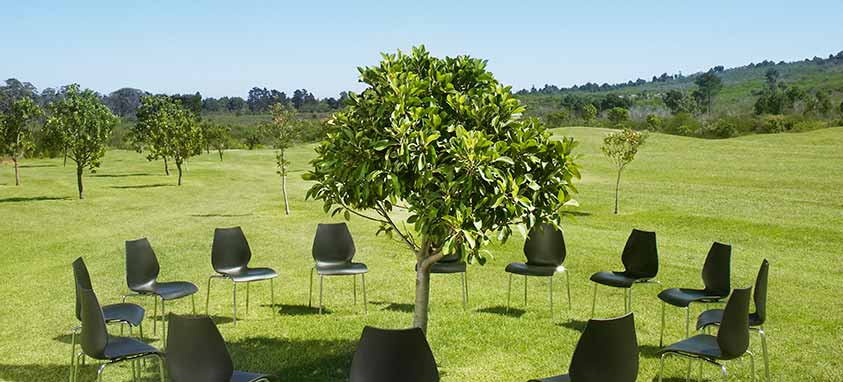What are you finding is most effective to have your attendees compliant with your green focus—give them the option to opt in for housekeeping programs, encourage vendors to not provide giveaways or are you needing to mandate the change? Metrics to share?
The key with engaging attendees is to always make “green” the default choice wherever you can, but also ensure they have a choice. So that means no daily paper or linen change unless they request otherwise. No printed program unless they ask for it during registration. Carbon offset opt-in checked by default in registration, with the option to click it off. The simple act of making a carbon offset an opt-out instead of opt-in increased participation in Oracle’s program by 15%. It’s helpful to transition gradually with these programs. Maybe having an opt-in for a year or two, then shifting to opt-out, then mandating completely. That way it’s less abrasive to participants. Exhibitor giveaways are tough, because it can be hard to say no to participants that provide booth sale revenue. The same approach can work. You might start with a voluntary exhibitor greening program with attractive incentives. And then move on to a mandated contract clause where certain kinds of giveaways or practices are not permitted. An exhibitor advisory focus group can help you determine a workable pace for changing practice.
Any tips, as a Convention Center, how can we encourage green meetings in a meaningful, impactful way?
Presenting a clear summary of your day-to-day business practices is a good place to start. Let the planner know that by default they are meeting in an efficient, green building that operates in a socially responsible way. And that by just saying yes to your venue many things are already taken care of, so it’s easy! If these translate into specific energy, water, waste and cost savings let them know. Beyond that, it is helpful to have a clear summary of added options a planner can choose to do to go farther. Perhaps it is a 100 –mile menu, optional service projects, green energy purchasing options, or other efforts. Making them clearly available in a brief “green meetings” kit can really help make them easy to say yes to. Also, convention centers could be encouraged to make event footprint reporting a standard practice. So planners always get a statement of their energy, water, waste and/or carbon impacts. If suppliers really want to shift planner behavior to actions that have less negative impact, informing them of their impact is an important first step. This gives a baseline that can then be compared and improved moving forward.
What’s the best way to make ground transportation more green besides Shuttle Service?
Transportation can be approached a variety of ways. Choosing a walkable location for your meeting can help eliminate or reduce shuttles. A walking challenge can also be a fun way to encourage less riding and more exercise. Sponsored bike share programs or pedi-cabs also add an element of fun. Where shuttle service is necessary to reduce congestion and carbon impacts try to follow a few rules of thumb when you source:–Ask if the shuttles are located in town, or being driven in from afar.
–Ask for newest shuttles with most efficient technology.
–Ask for alternative fuel shuttles if available, including fuel cell and biodiesel buses.
–Try to run at full loads whenever you can. And if you’re not tracking shuttle use, designate someone to monitor how full buses are running so you know if you’re running the right number on the best schedule.In addition to shuttles, think about if car-pooling or ride-sharing is appropriate for your group.
What one thing have you found ‘easiest’ to measure in greening your meetings that also brings good return when communicated—knowing that measurement is not necessarily easy?
Waste is fairly easy to measure. It’s also readily understood by people when you look at the numbers. In addition, it is one of the event impacts that you have the greatest control over, making it a good metric to design a management program around. Food waste specifically is a very hot topic that people care about, and are often keen to act on.
How do you get executives and attendees to get on board while keeping a high level of service? For example, not offering bottled waters, not offering beef as entree, asking for carbon offset fee during registration?
First, I think in many cases the fear of what attendees will think if something is changed can be unfounded. Executives are also particularly attuned to the reputation and brand impact (or risks) personal sustainability actions can have. Last year, Oracle quietly removed more water and carbon-intensive beef from lunch menus and no complaints were received. Granted they didn’t make a production of it, but it did not seem to be missed. Some choices also present an opportunity to step-it-up, too. For example, Cirque de Soleil’s traveling shows don’t sell disposable bottled water, but you can get a beverage in a nice, high quality reusable container. Yes it is more expensive, and to anticipate this criticism, Cirque provides information about their support of water-conservation organization One Drop, and why purchase of the reusable bottle is important at point of purchase. This kind of approach can soften the feeling of doing without or being inconvenienced by providing immediate, positive reinforcement to the attendee about the difference they have made.
What is the single most carbon reducing portion of a meeting?
Air travel typically accounts for most emissions at a meeting. So meeting in a location that minimizes air lift or uses virtual technology is the biggest thing you can do to reduce carbon impact. Following that, energy for guest rooms and meeting space typically have the greatest impact, making it important to choose green hotels and venues that operate efficiently.
Can you address locally-sourced food in terms of how it fits into green meeting planning?
Local food is often preferable for a green meeting as it is fresher, supports the local community and reduces carbon impacts from transportation. This isn’t always the case, though, as growing and processing some types of local food can be carbon intensive. Take greenhouse vs field tomatoes, for example, where the former takes a lot of energy to produce. What can help is to ask for locally produced food that is seasonal and climatically appropriate. Minimizing air-freighted food is particularly important. Local food that is traditionally prepared can also add a unique experience element to a meeting.
How would you handle introducing green meetings in a culture that does not embrace it?
Top-down green meeting programs can be tough if the staff is not supportive. Involving planning staff in determining their green meeting objectives and practices can help instill a sense of ownership that promotes culture change. Starting small, with a few easy steps can make it more manageable. Incentivizing involvement through employee rewards can help, too. Bottom-up green meeting programs typically require getting buy-in from senior management in ways they perceive have value. So that might mean stressing the cost-saving benefits. Or perhaps they are keen to influence supply chains and increase employee engagement and morale through sustainability. If they initially see success in areas they perceive have value they are more likely to embrace future efforts.
What have you found to be biggest source of food waste?
Those events that pay close attention to providing accurate guarantees and ask about portion size tend to experience less food waste. Those that also track what food comes back to the kitchen to adjust future ordering also produce less waste. Avoiding customization so chefs can refer to patterns of consumption on standard menu items is often not considered, either, and can keep waste down. Another successful strategy is to plan meals that beget ingredients for other meals. So starting with a beef roast for dinner that can then be used for sandwiches and soups. It is also great to see more willingness to use “imperfect” vegetables (picture knobby carrots) in meals, which may also present cost savings.
How do you stop the bottled water waste? Buying reusable cups does not work over several days due to cleaning issues. Paper/plastic cups—same thing as bottled water, correct?
A helpful way to look at reusables vs disposables is to consider how many times the glass would need to be reused to make the lifecycle impact less than the disposable option. So for example, the best type of hot beverage cup to use at an event depends on risk of breakage, and if you expect them to be returned for reuse. If you anticipate your mug will be used at least 40 times then it’s likely a better option than paper. This is highly likely if you’re meeting in a hotel or restaurant. To make it a better option than foam you should aim for approximately 1,000 reuses, possibly less. Something that is definitely possible for an office staff room, restaurant or hotel, but possibly a stretch for an outdoor festival, very large event or facility without carpeted floors. And it’s not just waste, but health and safety that sometimes need to be considered. So even though polystyrene might seem better than paper or ceramic due to cost and manufacturing footprint, lack of recycling options limit its consideration as a “green” alternative. Like most things related to sustainability, it is a complicated issue involving many tradeoffs. In the case of bottled water, where you find it is necessary (for safety, for example), there are solutions involving boxed water and bottle collection and recycling that can be used to mitigate some negative impacts.
 |
Paul Salinger Vice President of Marketing Oracle |
 |
Shawna McKinley Director of Sustainability MeetGreen |
Sponsored By





